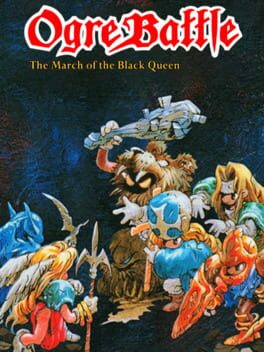Ogre Battle: The March of the Black Queen presented an interesting wedding of JRPG and RTS, pairing the former's battle system, character progression and artstyle with the strategy, scale and troop movement of the latter. The concoction - however, only represents half the scope. What lies ahead is a dizzying amount of different gameplay systems and rules with plenty of class/troop builds to experiment with.
The amount of customization options and details is overwhelming. While disguised as a simple war simulation/management game, Ogre Battle contains a cauldron of RPG aspects feeding into three distinct areas of gameplay: battle maps (where allied races and troop builds prevail), combat (relying on strategic team formations), and a universal morality system (the biggest factor shaping its story, affecting and affected by many player decisions), tied together by mechanical chemistry to weave a vast spiderweb of ideas. Surprisingly - the slow pacing, quasi-passive fights and agonizing difficulty isn't enough to derail the amount of enjoyable depth here. The mission-based format benefits the work as well, providing room for largely unique areas with plenty of bonuses, secrets, loot and side quests to uncover, while the writing bestows more flavor to each map and covers a vast gamut of morals and moods. Each of these maps could be an entire game for less capable developers.
Indeed, the writing represents another high point - a dark, political work that shuns the individual adventure in favor of perspective, injecting its initial good vs. evil (rebel vs. empire) paradigm with heavy doses of grey. Representing that is a branching storyline complete with 13 different endings, that simply takes advantage of the aforementioned morality mechanic and side quest variety. Heroic expectations unravel here to expose the confused, complex nature of war. Quest showed how a less 'personal' journey could feel more profound and powerful.
The amount of customization options and details is overwhelming. While disguised as a simple war simulation/management game, Ogre Battle contains a cauldron of RPG aspects feeding into three distinct areas of gameplay: battle maps (where allied races and troop builds prevail), combat (relying on strategic team formations), and a universal morality system (the biggest factor shaping its story, affecting and affected by many player decisions), tied together by mechanical chemistry to weave a vast spiderweb of ideas. Surprisingly - the slow pacing, quasi-passive fights and agonizing difficulty isn't enough to derail the amount of enjoyable depth here. The mission-based format benefits the work as well, providing room for largely unique areas with plenty of bonuses, secrets, loot and side quests to uncover, while the writing bestows more flavor to each map and covers a vast gamut of morals and moods. Each of these maps could be an entire game for less capable developers.
Indeed, the writing represents another high point - a dark, political work that shuns the individual adventure in favor of perspective, injecting its initial good vs. evil (rebel vs. empire) paradigm with heavy doses of grey. Representing that is a branching storyline complete with 13 different endings, that simply takes advantage of the aforementioned morality mechanic and side quest variety. Heroic expectations unravel here to expose the confused, complex nature of war. Quest showed how a less 'personal' journey could feel more profound and powerful.
